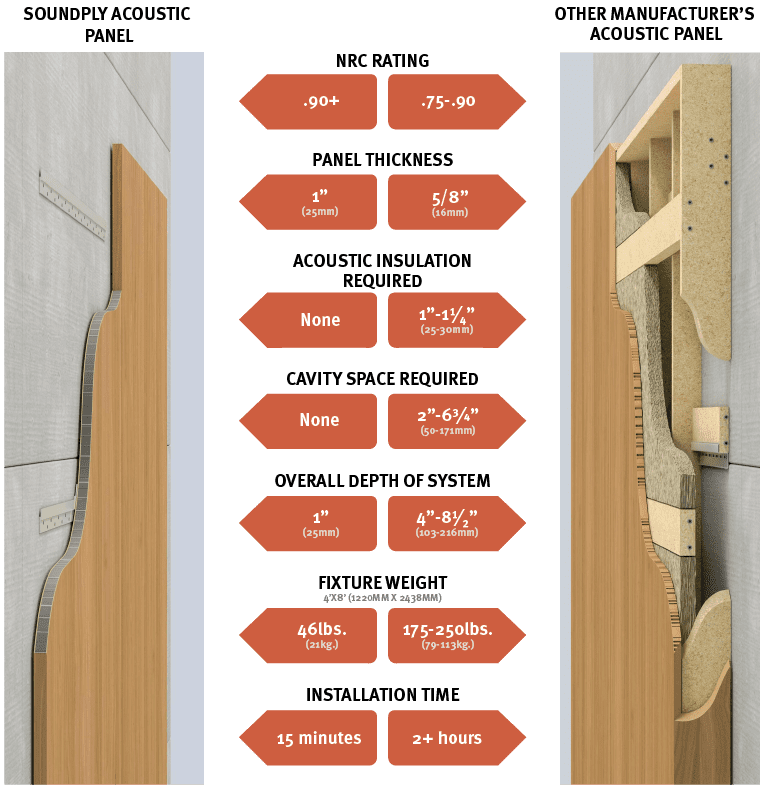Noise is the top complaint for restaurants, workplaces, hospitals, hotels, and multi-family residences. The Irish playwright and writer, Richard Steele, describes a likely reason,
“I have often lamented that we cannot close our ears with as much ease as we can our eyes.”
While noisy places speak volumes, good acoustics make themselves known by their invisibility. But though we may take them for granted, seldom do they happen by chance. Understanding sound and its positive or negative impact on people is both a science and a specialty. To create a notable space that meets or exceeds a client’s expectations, include an acoustician in your plans.
Here are five reasons you won’t regret it.
1 Meet Expectations
“Low is the mountain, high the expectations.” Malawian Proverb
When designing and planning, clients often overlook how they want their space to sound. Even though good acoustics might not be mentioned as an objective, it doesn’t mean they aren’t an expectation. Clients see acoustics as a clear-cut usability factor. They expect architects and designers to anticipate the needs of the space regarding sound and noise.
Ideally, it’s best to include an acoustic consultant early in the programming and schematic design phase. With their insight, you’ll be able to proactively address your client’s needs while any needed changes are still on paper. This ensures the best design options are still available. For example, an acoustician can look at the drawings and note potential sources of noise that could conflict with the use of the space. They may suggest, ‘Let’s not put the elevator next to that critical space’ or recommend an elevator designed to be quiet. This ensures the space is as functional acoustically as it is physically.
By catching potential problems before they happen, the best and most cost-effective solutions are available. This also limits expensive redesign and retrofitting for acoustic products post-construction.
2 Reduce Liability
“Things done well and with a care, exempt themselves from fear.”William Shakespeare
The Center for Disease Control estimates 22 million adults in the United States are exposed to noise levels causing hearing loss. Dangerous noise isn’t just in the places we expect, like airports or manufacturing jobs. A loud restaurant can have noise levels above 85 dBA, putting staff at risk of noise-induced hearing loss.
For the well-being of those using the space, it’s important to note that building and construction codes are only the minimum requirements. To create acoustically safe, healthy, livable spaces often requires going beyond code. Voluntary standards, such as the WELL Building Standard™ and LEED v4 (Leadership in Energy and Environmental Design) provide great benchmarks for acoustic comfort. An acoustician can ensure compliance with these voluntary standards, IBC guidelines, and OSHA..
An acoustician’s experience and expertise brings peace of mind and confidence that buildings will be acoustically safe for those using them.
3 Identify False Claims
“Even though you know a thousand things, ask the man who knows one.” Turkish Proverb
Things aren’t always what they seem. The acoustic product industry is poorly regulated. Many products with seemingly high NRC ratings are actually hiding behind the fine print on their installation requirements or test conditions. For example, many planks and panels labeled as acoustic only absorb their listed NRC if part of an acoustic system. The product alone isn’t acoustic and must be backloaded with sound absorbent material and plenum space. This limits application, complicates installation, and adds cost. Most importantly, it can mean a client isn’t receiving the expected acoustic absorption.
A true acoustic plank or panel is one in which the product itself can absorb sound. It doesn’t need any other acoustic material or plenum space but can stand-alone and achieve the listed NRC rating. Using a true acoustic panel or plank saves on installation time and has a performance guarantee. They’re also versatile with many more application possibilities.
With so many options available for acoustic products, having an acoustic consultant narrow the field to the top choices can be a relief. From micro-perforated wood panels to acoustic ceilings, an acoustician will make sure the chosen product delivers the best quality.
In the comparison below, both products claim to be acoustic panels with a high NRC but only one is a stand-alone acoustic panel.
4 Make it Memorable
“Architecture is really about well-being. I think that people want to feel good in a space… On the one hand it’s about shelter, but it’s also about pleasure.” Zaha Hadid
An acoustic consultant can add personality and character to a space by defining the liveliness and clarity of the sound experience. Do you want your space to have a dynamic energy or a quiet hush? An acoustician can help you create an intentional acoustic signature.
Acoustics are a unique opportunity to elevate a design beyond what’s common and turn it into a memorable, sensory experience. For example, when acoustics harmonize with the rest of the design, a restaurant becomes more than just a place to eat; it’s where families go to reconnect. An office becomes more than a place to work; it’s where creativity and vision come to life. A hospital becomes more than a place for the sick; it’s where healing takes place. A performing arts center becomes more than a building; it’s a wellspring for shared human experience and emotion.
When all of the design elements of a space work together, there aren’t distractions. It simply works and we know it by the emotive response it evokes. Good acoustics are a significant part of creating a memorable, holistic experience so when people go to the restaurant (workplace, hotel, home, etc…) their only focus is on the life that happens there. An acoustic consultant brings the whole experience together.
5 Reduce the Cost
“To guess is cheap. To guess wrong is expensive.” Chinese Proverb
Design guides give helpful insight on acoustics but can be confusing, as well. They often list conflicting considerations for a space and it can be difficult to identify which factor is most important. Is it the vibrations in the floor, having solid partitions, or having enough absorptive material in the space? An acoustic consultant will eliminate the guesswork by telling you how to prioritize, so you can work within your budget to achieve the best results.
They’ll take a complete survey of the space, taking into account exterior noise, mechanical systems, use of the space, and other potential sources of noise. With the big picture in mind, they’ll identify the best options for your needs. This means you won’t spend an exorbitant amount on a noise-reducing door or wall treatment and undermine it with other poor design elements.
Their identification of problems and the best way to address specific acoustic challenges means you can be judicious in the use of materials. Money won’t be spent on the wrong products or effort in the wrong places. It also means there won’t be costly retrofit and redesign for acoustics, as well. You can be assured of having the best results at the best price, with their experience easily paying for itself many times over.
So many details clamor for attention with each project. To quiet the noise and simplify, include an acoustic consultant on your team. Their expertise will make your space memorable and in tune with your client and end user’s needs – bringing budget, beauty, acoustics, and purpose together in harmony.
Interested in learning how acoustics impact the guest experience? Check out this guest post from Aercoustics acoustician, Steve Titus: “Don’t Let Noise Eat Into Your Restaurant Business.”






